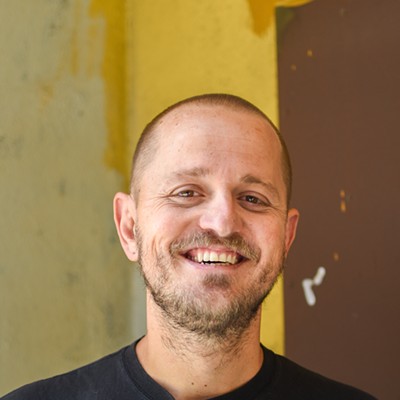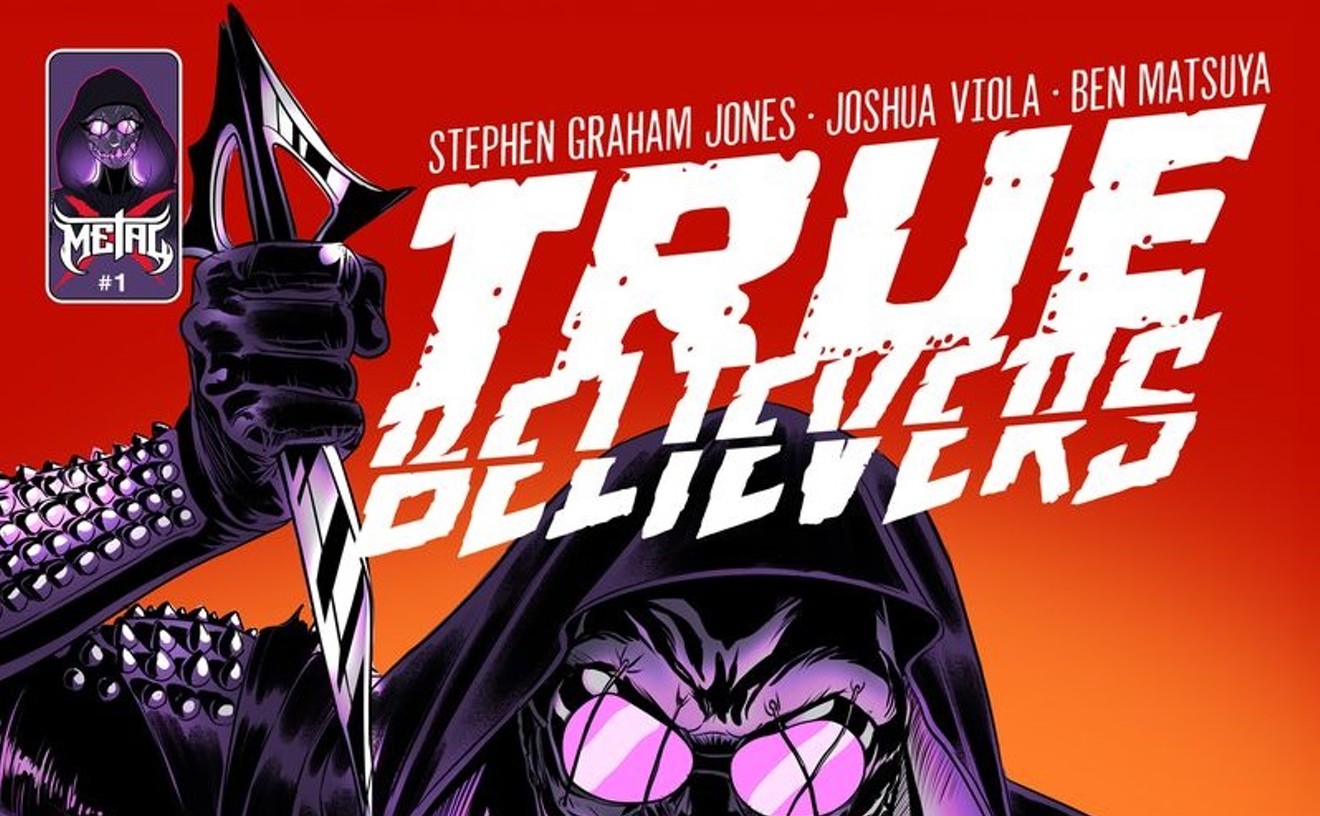Whether she's dealing with the Patriot Act, Manifest Destiny or the menacing drama of high school life, Sears creates captivating narratives while exploring the limits of experimental animation techniques and collage -- using both story and frame-by-frame manipulation. In advance of her presentation at First Person Cinema tonight, we spoke with Sears about her work.
See also: Karen Yasinsky Talks Surrealist Animation and Boredom
Westword: Talk about your project and this specific style of work you've been developing.
Kelly Sears: I guess it really grows out of a lot of different interests I have. I love animation. I don't know how to draw, and I'm not actually interested in learning how to draw. But I am interested in things like collage and layering it and building these larger compositions. That's how I really got into animation. As I was making films, I was really into collecting things or re-appropriating material.
The path really developed along those two interests: using animation, strategies like collage, compositing, layering, masking and kind of foraging for ephemeral media and archival media. It became a way of using animation almost as a critical means to talk about the content and the histories that are in the histories that I've collected.
How do you decide what images and themes you use? Are these films fictional?
They're as fictional as nonfictional. They really have a foot in both places where the narrative will go along and we can understand it as our own history and we can understand it as a detour into a more uncanny space, but often that detour comes around and is really set up to talk about contemporary political histories that we're experiencing right now.
Talk about some of the issues you're dealing with.
Well, the films feature lost astronauts and haunted presidents and possessed high schools and lots of different kinds of traces of disaster. Looking for material is very serendipitous. There are a bunch of archetypes and themes that I'm interested in, such as Manifest Destiny, occupation, surveillance. When I'm out looking at images, either at formal archives or at thrift stores and flea markets, there is always a certain amount of conversation about American history that I'm interested in. And so, I will find an archetype like an astronaut and latch on to that and think about how that figure can embody some of these stories.
In The Drift, you're going from this astronaut universe into counterculture and then look at the death of that. Is that more or less the narrative that you're dealing with?
I was thinking about the space race as a larger ideological metaphor and thinking about what happened in American history and what engagement was attached to that. I made that film during the occupation of Iraq and it was very much after mission accomplished was declared. I was thinking about these questions of frontiers and occupation and these more ideological gestures. The astronaut became a really beautiful metaphor for that. And of course, things don't work out for the astronauts in this piece. That moment of American history gets reconfigured. But it was all about thinking about questions of home and on the other side other imperial histories that take over.
Read on for more from Kelly Sears.
What is your medium? Film? Digital?It's all digital. My background was in film and at some point I started working digitally and really thought about film with these questions about texture and visual kineticness. I had used these old animation tools like the Oxberry and the optical printer when I was in college and then really transposed that very analog way of working into digital processes. I mostly work with AfterEffects with animation and am really using it as if it was this other device that I learned on.
Talk about distribution with this kind of work.
In terms of distribution, everything is digital. There's really great arguments for screening in a variety of venues. It's wonderful to screen in a theater because the image is big and beautiful and there is this wonderful spectacle of cinema. It's great to screen in art galleries because there is this whole other kind of conversation. That's kind of the whole point of showing work is to have conversations around it and to have it connect with our daily lives and how we see what's happening around us.
When you're talking about theaters, are you talking about festivals? Where do you screen?
I would say I mostly screen in film festivals, from the spectrum of experimental festivals to Sundance. Sundance just launched an animation tour, a selection of films from their last two years. Voice on the Line is going to be doing a national tour in that program. You really get different kinds of conversations in different festivals, and that's great. But I also screen in art galleries. I have things online. I don't personally enjoy watching things online, but sometimes that's the only way you're going to have access to stuff. There are plenty of things that I've seen online just because that's my only option.
I was really impressed with the number of views your films had on YouTube. For experimental work, that seems really outstanding.
You know, it's funny. It's great. A previous link that Sundance had hosted for Voice On the Line ended up on Google's homepage one day, and at some point, it had like 100,000 hits -- which for a really scrappy, collage animation that is being critical of the Patriot Act, it's great that people are willing to go there. I think people really want to see different stuff and want to engage with different visual languages and different storytelling styles. I don't think we have a lot of access to that normally. If you really seek out experimental voices, you can find them. But I don't think that's the majority of viewers. That's not to say they won't enjoy that form of storytelling. It seems like people who come across it enjoy it, but I don't think the majority of media viewers are actively seeking out experimental work. How much do you see yourself in that experimental genre? Your work is accessible in a way that a lot of experimental work isn't. Your work's viscerally enjoyable.
I really am a product of experimental cinema, but I'm also a product of narrative cinema, and I love documentary cinema. I try to bring in storytelling structure that can function as a mechanism in the piece, so we can all kind of get into it and circle through it. A lot of my films have voiceovers. For me, thinking about how the voiceover functions in documentary by replicating it, in some ways, and by undermining it in other ways, I think that's a very easy way to get into a piece. If there is a voice and there is a story, you can go along with it.
Read on for more from Kelly Sears.
The work demands a different form of exhibition than the traditional experimental film festival.What should we do about this?
Do you think anything is being done about that?
Distribution for experimental shorts?
Yeah. I think there is. Overseas, in Europe, people watch shorts. People watch TV programs with shorts. People watch shorts where films are playing. Here, we have this dominant model of the feature film at the Cineplex or the television show at home. I think there are a lot of really great organizations that take shorts really seriously. Sundance has been doing these really great tours of short films from each year's festival and taking them to theaters across the country.
When was the last time you went to a movie theater and just saw a shorts program? Probably not unless it was at a festival. I think that's one model of doing it. There is a distribution company called Cinemad that's put out a shorts almanac. All the festivals will do mix DVDs that you can purchase. But again, you have to seek it out. There are these little bite-sized, wonderful pieces of film that are out there, and unfortunately, you really have to seek them out. It's not a go-to format; it should be.
I think short films are wonderful. So much can happen in a short amount of time. I always think of the analogy of the short story. They are easily digestible bits of narrative. It's wonderful. I think short stories are read a lot more than short films are sought out. People should look. There is a lot of amazing work out there.
I'm curious about your relationship to sci-fi as a genre? Are you a big sci-fi geek?
No, I'm not. I should be more than I am. I like sci-fi films, especially '60s and '70s ones. Animation allows you to do something you can't do in the real world. In a way, science fiction allows you to also do things you can't do in the real world. I think my films are fantastical and using science fiction and animation becomes this really great connection between storytelling and visuals to kind of take the ordinary into the bizarre and the dystopic. Are you as dystopic as your films?
I am exceedingly critical and concerned but with a sunny disposition.
Kelly Sears will be showing her short films at 7 p.m. tonight at First Person Cinema, at the CU Visual Arts Complex, 1085 18th Street in Boulder. For more information, go to the First Person Cinema website or call 303-492-1411.
Find me on Twitter: @kyle_a_harris











